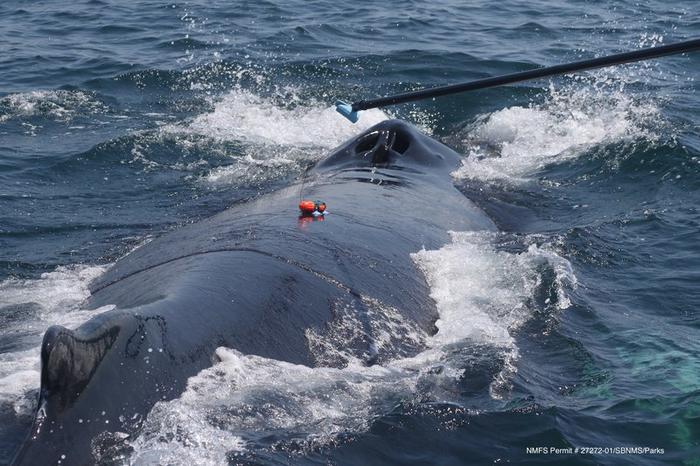For researchers studying the acoustic behavior of whales, distinguishing which animal is vocalizing is like a teacher trying to figure out which student responded first when the entire class is calling out the answer. This is because many of the techniques used to capture audio record a large sample size of sounds. A major example of this is passive acoustic monitoring (PAM), which records audio via a microphone in one location, usually a stationary or moving platform in the ocean. While this method allows researchers to gather acoustic data over a long time period, it is difficult to extrapolate fine-scale information like which animal is producing which call because the incoming audio signals could be from any number of animals within range.

Credit: Syracuse University
For researchers studying the acoustic behavior of whales, distinguishing which animal is vocalizing is like a teacher trying to figure out which student responded first when the entire class is calling out the answer. This is because many of the techniques used to capture audio record a large sample size of sounds. A major example of this is passive acoustic monitoring (PAM), which records audio via a microphone in one location, usually a stationary or moving platform in the ocean. While this method allows researchers to gather acoustic data over a long time period, it is difficult to extrapolate fine-scale information like which animal is producing which call because the incoming audio signals could be from any number of animals within range.
Over the last 20 years, the invention of acoustic tags equipped with movement and audio sensors, which are suctioned harmlessly to the animal being studied, has tremendously improved data collection capabilities. Researchers in Syracuse University’s Bioacoustics and Behavioral Ecology Lab, led by Susan Parks, professor of biology, have been utilizing this technology to study the behavior of humpback whales in the North Atlantic Ocean. In a recent study published in Royal Society Open Science by Julia Zeh, a Ph.D. student in biology, along with other members of Parks’ lab and collaborators from NOAA, the Center for Coastal Studies, and UC Santa Cruz , researchers tagged many whales from the same pod simultaneously to analyze the vocalization of all members in the group. The goal of this research was to uncover new information about whale behavior and communication – insights which are crucial for informing future conservation efforts.
“By simultaneously tagging all whales in a group, we were able to compare how loudly calls were recorded across tags to infer who was calling,” says Zeh. “This in turn lets us look at individual and group-level communication in ways that we couldn’t before.”
The team analyzed nearly 50 hours of synchronous tag data which included 16 tags from seven distinct groups of whales. Sound and movement data were collected from humpback whales in the Gulf of Maine near Stellwagen Bank National Marine Sanctuary in the western North Atlantic.
While the function and meaning of specific humpback whale calls remains largely unknown, researchers hypothesize that the calls might be associated with feeding or other social coordination. The team’s simultaneous tagging method allows researchers to analyze acoustic data about individual whales and compare that in the context of the larger group.
“This information can give us insight into how whales coordinate behaviors, how their calls relate to what they’re doing, what types of calls they use and what information they might exchange in group communication,” says Zeh. “Understanding acoustic sequences within and between individuals also gives us insight into the complexity of the humpback whale communication system.”
What’s more, if researchers know who is calling, they can associate vocal behavior with individual age, sex or the behavioral context of the calls. This data can also be used to enhance PAM studies, which are commonly used for species’ presence/absence verification and population counts.
“Having information from tag data about call rates and timing can improve count estimates,” says Zeh. “For example, having 10 calls doesn’t necessarily mean there are 10 whales, but potentially two whales calling back and forth, or one whale producing sequential calls.”
While previous studies have linked caller identity to acoustic tag data, this is the first robust method for studying large baleen whales, like humpback whales. The team’s efforts to enhance caller identification through simultaneous tagging provides a new resource for researchers to better understand animal behavior and advance wildlife conservation efforts.
The team’s work was supported by the Stellwagen Bank National Marine Sanctuary, the Office of National Marine Sanctuaries, the National Oceanographic Partnership Program, the National Defense Science and Engineering Graduate Program, the Office of Naval Research, the ACCURATE Project, the Cetacean Caller-ID project and the U.S. Navy Living Marine Resources Program.
Journal
Royal Society Open Science




